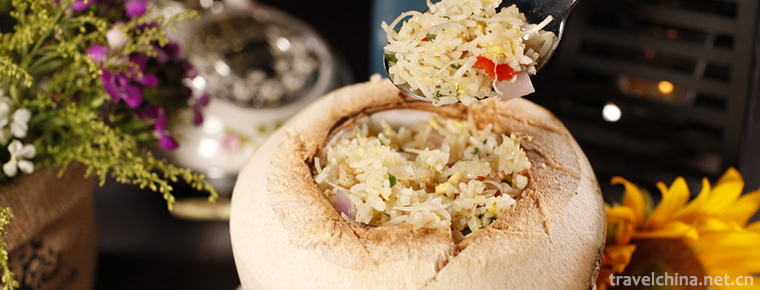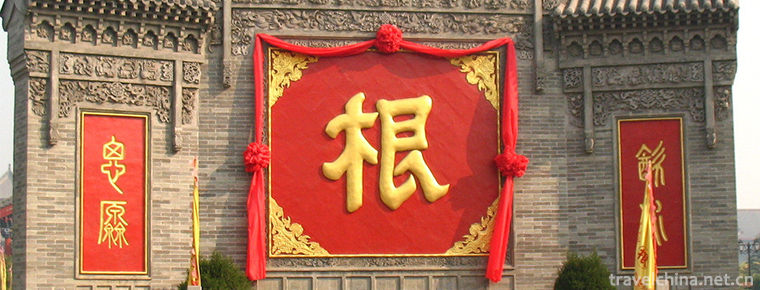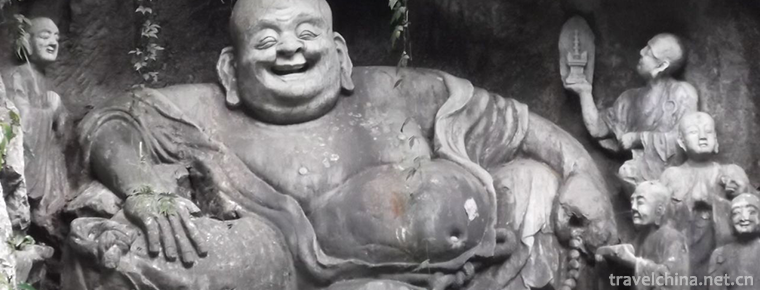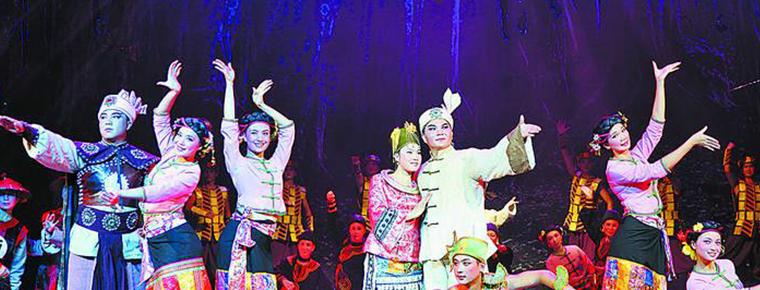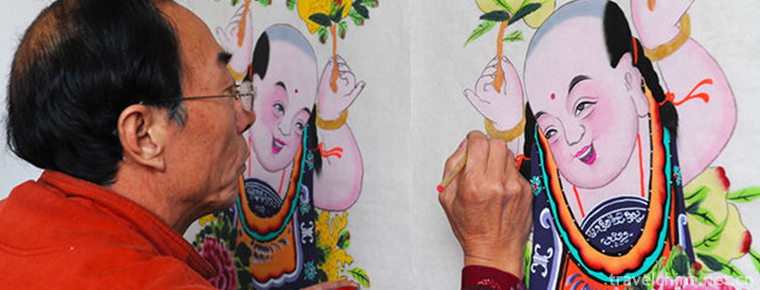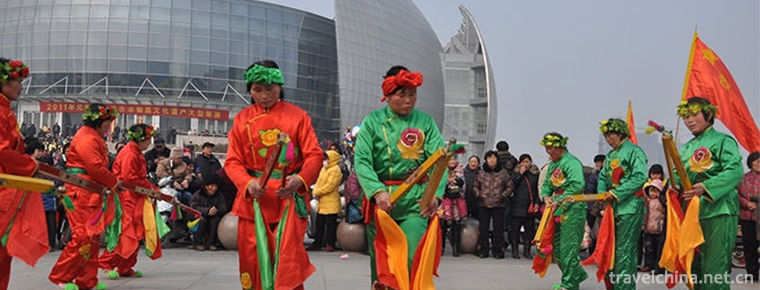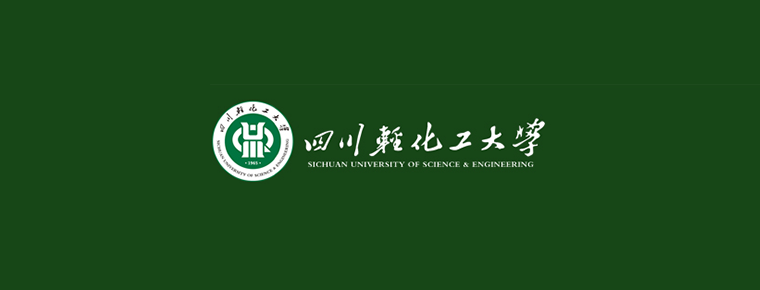Mount Longhu Scenic Area
Located in Yingtan City, Jiangxi Province, the Longhu Mountain Scenic Area is 18 kilometers away from the city center. It consists of six scenic spots: Xianshuiyan, Longhu Mountain, Shangqing Palace, Hongwuhu Lake, Mazuyan and Yingtian Mountain. It has 55 scenic spots and 261 scenic spots with an area of 200 square kilometers. In addition, it also includes independent scenic spots (spots) such as Guifeng in Yiyang, covering an area of 40 square kilometers.
Longhu Mountain is China's eighth World Natural Heritage Site, World Geopark, National Natural and Cultural Heritage Site, National 5A Scenic Spot, National Forest Park and National Key Cultural Relics Protection Unit. The whole scenic area covers 220 square kilometers. Longhu Mountain is a typical Danxia landform in China.
Longhu Mountain is the birthplace of Taoism in China. Its Taoist holy place, Bishuidanshan Mountain and ancient cliff tombs are known as the "Three Wonders".
Longhu Mountain has 62% forest coverage, abundant rainfall and warm climate. The content of negative air ions in Longhu Mountain scenic spot exceeds the normal value by 15 times. It is the top natural oxygen bar in China's domestic scenic spots. In September 2017, he won the title of "Natural Oxygen Bar in China". The Best Global Tourism Destination of China National Tourism in 2018.
In 1988, it was approved by the State Council as a national key scenic spot.
Joined the World Geopark Network in 2007.
In 2009, Longhu Mountain was also included in the Gold Award of "Favorite Tourist Scenic Spot for Chinese College Students".
Longhu Mountain is a project recommended by China to UNESCO World Natural Heritage Center by the State Council in 2009. It is the only project to apply for Heritage in China in 2010.
On August 1, 2010, the 34th World Heritage Conference, held in Brasilia, Brazil, included "Danxia of China" (Longhu Mountain) in the World Heritage List. Longhu Mountain has become the eighth World Natural Heritage Site in China.
On April 27, 2012, the National Tourism Administration officially awarded the title of "National AAAAA Tourist Scenic Spot" to Longhushan Tourist Area.
Longhushan Scenic Area is located 20 kilometers southwest of Yingtan City, the transportation hub in eastern Jiangxi Province.
topographic features
Longhushan is one of the best developed areas of Danxia landform in China, and belongs to Xinjiang fault basin in geological structure. The basin began to form in the late Triassic. From the late Jurassic (150-140 million years) to the early Cretaceous (14-09 million years), active volcanoes erupted and deposited muddy sandy rocks of fluvial and lacustrine facies, which laid a material foundation for the formation of volcanic landforms in this area. By the late Cretaceous (0.9-0.67 billion years), the basin expanded and deposited a set of thick purple-red river-lake clastic rocks (conglomerates and sandstones) which provided material conditions for the formation of Danxia landform in this area. Later crustal movement transformed the area into land. External geological processes such as flowing water scoured along rock fissures, eroded and cut, coupled with gravity collapse, gradually formed the typical Danxia landform landscape in this area. Its genesis types are: water erosion erosion type, collapse residual type, collapse accumulation type, dissolution weathering type, dissolution weathering collapse type. In the form, there are: Stone stockade, stone wall, stone beam, stone cliff, stone pillar, stone peak, peak cluster, peak forest, first tier sky, single side mountain, pig back hill, honeycomb cave, vertical cave, natural bridge, Shimen, etc., and there are various anthropomorphic and beautiful .
Climatic characteristics
Longhushan scenic spot belongs to the humid monsoon climate in the middle subtropical zone. It has the characteristics of no heat in summer, no severe cold in winter, warm and humid, and distinct seasons. The annual average temperature is 18.0 C, the average temperature in January and July is 5.5 C and 29.7 C, the extreme maximum temperature is 40.7 C, and the minimum temperature is - 8.6 C. The annual average rainfall is 1878 mm and the annual average evaporation is 1648.4 mm .
hydrographic features
Longhu Mountains are rich in groundwater resources, especially in mountainous areas where vegetation is well developed, bedrock fissures are water-rich, topography is deep cut, groundwater circulation is good, and groundwater can easily flow down rivers and valleys when it is not far from the hillside. From mountain area to river valley, the mineralization degree of groundwater is obviously improved, showing moderate to weak acidity, soft to slightly hard water, and colorless, odorless, transparent, with very little suspended matter. The water temperature is usually between 17 and 20 degrees Celsius.
Botany
The flora of Longhushan Scenic Area belongs to the humid forest area in southeastern China, the evergreen broad-leaved forest subzone in the central subtropical zone, and the evergreen Castanopsis fargesii forest and Pinus fir forest area in the Western foot of Wuyi. Superior natural conditions breed abundant plant resources. According to statistics, there are more than 460 species of plants belonging to 250 genera and 100 families in the region.
The main forest types are broad-leaved forest, coniferous-broad-leaved mixed forest and coniferous forest. Broad-leaved forests are mainly distributed at altitudes of 300-800 meters, and supernatant, ear mouth, cold water and other places are the main distribution areas for their concentrated and continuous, and they are multi-level forest belts. The upper layer is mainly composed of Castanopsis fargesii, Quercus, Castanopsis, Coca, Liquidambar and Schima superba, while the middle layer is dominated by sub-trees such as Huangduanmu, Yangtong, Litsea cubeba and some large trees cutting Castanopsis sprouts, while the lower layer is dominated by more than 100 kinds of small shrubs such as Yingrenmu, Wuyao, Rhododendron, Niubei, Euonymus, Wufang and so on. Among them, there are large areas of Moso bamboo forest, mainly distributed in the ear mouth, cold water and other places. In broad-leaved forest belts, the higher the altitude, the fewer species. From 700 to 800 meters above sea level, only a few species of Fagaceae and Magnolia are found, and small areas of Pinus taiwanensis are scattered in some mountainous areas. At an altitude of 300-610 meters, there are more than 100 families and genera and 400 broad-leaved forests.
Longhushan scenic spot has a total land area of 23 218 hectares, a forest area of 14 300 hectares, a forest coverage rate of 62%, a standing stock of more than 500,000 cubic meters, and more than 1.7 million living bamboos. Longhushan scenic spot is located in subtropical humid area, with diverse biology and abundant vegetation. The forest vegetation distribution belongs to subtropical evergreen broad-leaved forest area. The flora of Longhushan scenic spot is close to the Wuyi Mountain in Fujian Province, and it has the typical distribution community of animals and plants in Danxia landform area. The diverse ecological environment and abundant plant species provide good conditions for the reproduction and habitat of many insects, birds and mammals. The flora of Longhu Mountain is close to that of Wuyi Mountain in Fujian Province. Because of the high altitude and steep mountain terrain, the vertical distribution of vegetation is obvious. The main vegetation types are evergreen broad-leaved forest, evergreen and deciduous broad-leaved forest, coniferous forest, coniferous broad-leaved mixed forest, mountain top low forest, etc. Mount Longhu plant distribution: 1200~1300 meters above sea level, there are Hericium Rhododendron, Rhododendron fortunei, blueberry, arrow bamboo, Mount Huangshan Rhododendron, alpine boxwood, Mount Huangshan pine, Man Shanhong, Ma Yinhua, lantern flower, flat blueberry, sandwiched, mixed bamboo folder fan, Rhododendron fortunei, Rhododendron purple, cuckoo, water flower autumn, pig pig, stone ear and so on. From 1000 to 1200 meters above sea level in Tianmen Mountains, the top trees are mainly Pinus taiwanensis, accompanied by Schima superba, Magnolia Magnolia and Yellowwood of East China. The tree height is between 7 meters and 20 meters, and it grows well. The lower trees include lantern trees, camellia, mountain cherry, Rhododendron, camellia, Herba taxoidea, Berberis, Berberis, Rhododendron erinaceus, Rhododendron fortunei, Salix prickly, pig ear thorn, three branched Lindera, Mount Huangshan Acanthopanax, Prunus billieri, magnolia flower, arrow bamboo, bitter bamboo, Phyllostachys Pinctata, Fu Jianbai and so on, so that the scenic spots in this area are long and green, and three. Spend ten thousand .
Animal
Longhu Mountain Scenic Spot has more than 40 kinds of mammals, accounting for about 40% of 106 species in Jiangxi Province.
There are more than 170 species of bird resources in scenic spots, accounting for more than 40% of 420 species of birds in the whole province. The Chinese Autumn Sand Duck along Luxi River in Shangqingsowan Section of Longhushan National Forest Park belongs to the first-class protected animal in the country.
Scenic spots know reptiles, mainly snakes, accounting for about one fifth of the province's snake species.
Among amphibians, giant salamanders (doll fish) are the most rare. There are also tailed amphibian fat salamanders and salamanders; tailless amphibian scenic spots abound, mainly frogs, black spot frogs, money frogs, marsh frogs, marsh frogs, rock frogs, rain frogs, thorn frogs (stone chickens) and tiger frogs .
Six scenic spots
Xian Shui Yan
Andromeda is a vertical cave formed by erosion and gravity collapse along the junction of two sets of joints. The bottom of the cave develops into a zigzag suspension groove .
Mount Longhu
Longhu Mountain was originally named Yunjin Mountain. In the middle of the Eastern Han Dynasty, Zhang Tianshi was here to make alchemy. "Dancheng made dragon and tiger present, and the mountain got its name." Longhu Mountain became the birthplace of Taoism in China.
Ying Tianshan
Should Tianshan mountains overlapping mountains, waterfalls and springs, beautiful scenery. Primitive forest shelters the sky and shades the sun, which is an important part of Longhushan National Forest Park. The main landscapes are Jingshe site in Xiangshan, Yingtian Temple site, Wolong in Yuyuan, Grade 7 waterfall, Yunke Zhenglu, steep slope in Songlin, Jiufeng Lianping, Bilian Pool, Pandiangshi, marble stone, Xieshi, etc.
Ma Zuyan
Mazuyan is north of Paiyashi, also known as Jilangfeng. It is said that Mazu, a great monk of Tang Dynasty, was named for his lectures here. There are two caves in the mountain, which can accommodate thousands of people. In front of the rock, there is a pestle, 111 meters high, standing on the Bank of the Shangqing River, such as a pillar of optimum sky. Next to the monkey head stone, there are ancient vines to connect the two, known as the "iron pillar lock golden monkey" .
Hong five Lake
Located one kilometer north of Mazuyan and beside 320 National highway, Hongwuhu Lake covers an area of 37 square kilometers. It is an important part of Longhushan scenic spot, including Honghu Reservoir and Wuhu Reservoir. The total reservoir capacity of Honghu Reservoir is 13.26 million cubic meters, with a maximum water surface of 4000 mu. It is the regulating reservoir of Baita Canal. The lake water is clean, bright and clear.
Shang Qing Palace
The Shang Qing Palace was built in the Eastern Han Dynasty. It is the sacrificial place of Taoism. It is one of the architectural communities formed on the basis of worshiping heaven and ancestors in ancient China. Its scale and grade are different and spread all over the country. The Shangqing Palace is not only the first one in the view of Jiangnan Palace, but also unique in China. It is known as "the city of fairies" and "the place where all gods work".
In 2014, 10.2 million tourists were received in the whole year, and the tourism direct income was 406 million yuan, up 56.8% and 52.6% respectively, ranking the top of the provincial scenic spots.
In 2015, the number and income of tourist attractions continued to rise, and the tourism economy maintained a vigorous momentum of development. During the whole year, 13.2 million tourists were received, and the direct income of tourism was 510 million yuan, which increased by 30% and 28% respectively, ranking in the forefront of the province's scenic spots.
taoist culture
Longhu Mountain is the "ancestral court" of Taoism, which has the status, function and great influence of inheriting the past and opening up the future in the history of Taoism in China. Longhu Mountain, formerly known as Yunjin Mountain, is a beautiful and beautiful mountain in the south of the Yangtze River. The peaks here stretch for tens of miles and are caused by the westward movement of a vein in the Xiangshan Mountains (Ying Tianshan Mountains). It is said that ninety-nine dragons gather here, like dragon pans, like tigers, dragons and tigers competing for power, and will not give way; Shangqing River drifts in from the east, travels slowly according to the mountains, turns around the mountains, like a rest, like a love scene, white across the beach, green when it meets the pool, or quietly elegant words, or meditation. Ninety-nine peaks, twenty-four rocks, as soft as possible to draw water, around the peak of the stream, Ninety-nine Dragons of masculinity, Shandan water green, full of spirituality. Soon, Lingshan beautiful water was among the gods, that is, two cranes led Zhang Daoling to take his disciples out of the mountain to practice Buddhism. Mountain God perception, dragon and tiger appear, instead of Yunjin. Since then, besides Longhu Mountain and Bishuidanshan Mountain, Taoist culture is beautiful, ranking first among the famous Taoist mountains, known as the first fairyland of Taoism.
Zhang Daoling, after the accomplishment of Taoism and alchemy in Longhushan, lived here by Zhang Shengshi, the fourth generation of heavenly teacher in the late Han Dynasty. He kept watch on the search for immortals in Longhushan, sat in the Qing Palace for teaching, lived in the temple of heavenly teacher, inherited Taoism for 63 generations, and lived for more than 1800 years. Taste, high-ranking officials, the formation of the Chinese cultural history of inheritance "Nanzhang Beikong (Confucius)" two great families. The Shangqing Palace and the Tianshifu of the next Han Dynasty received numerous grants of silver from dynasties and carried out numerous extensions and repairs. The area, scale, layout, quantity and specifications of the palace were the most important in the history of Taoist architecture. In its heyday, Longhu Mountain had more than 80 Taoist temples, 36 Taoist monasteries and several Taoist palaces. It was the real "Tao Capital" and the world kingdom of Taoists.
In addition, the Xiangshan Academy in Yingtian Mountain is the birthplace of the school of "epiphany" in ancient Chinese philosophy; Mazuyan in Jinlongfeng is the place where Mazu Tao, one of the most important Zen Buddhists in the history of Zen Buddhism, joined the early Zen Taoism; the cliff tombs in Xianshuiyan are the wonders in the history of Chinese burial custom; and "Xiannu Xianhua" is the first absolute spectacle of Taoism. The world's number one spectacle, and so on. The rich Taoist cultural heritage accumulated in Longhu Mountain for thousands of years, its prominent ancestral status in the history of Taoism in China, and its contribution to the development of Taoism in China are recognized as "the first mountain of Taoism" and have a very important position in the history of world religion .
From Huichang in Tang Dynasty to the end of the Five Dynasties, Zhang Ling's descendants in Longhu Mountain were Zhang Jian of the twentieth generation, Zhang Bingyi of the twentieth generation, Zhang Shan of the twentieth generation and Zhang Jiwen of the twenty-third generation. In this period, the Palace View was built, that is, Zhenxian View, Zhang Tianshi Temple and another Sanqing View. After entering the Song Dynasty, the descendants of Zhang Ling gradually received the attention of the court, and the Taoism of Longhu Mountain flourished.
In the Song Dynasty, there were a large number of famous Taoist priests in Longhu Mountain besides the heavenly teachers taught by the descendants of different generations. Lou Jinyuan's Longhu Mountain Records, Volume 7, lists 26 Taoist priests in Song Dynasty. Among them, Wang Daojian, Guixi and Shangqing Palace Taoist priests studied in Zhang Jixian. The Taoism of Longhu Mountain in Song Dynasty had a large number of palace views. First, several old palaces have been expanded and given quotas.
The Yuan Dynasty was the heyday of Taoism in Longhushan. The descendants of Zhang Ling in this period were from the 36th to the 40th generations. Their names were Zhang Zongyan, Zhang and Di, Zhang and Material, Zhang Sicheng, Zhang Side and Zhang Zhengyan in turn. From Zhang Zongyan, the Yuan Dynasty named him a teacher of heaven and a real man, who led Taoism in the south of the Yangtze River. In the thirty-eighth dynasty, Zhang Yucai was appointed as the first bishop of Zhengyi Church. He was the leader of Sanshan Fujian School.
In the early and middle Ming Dynasty, the descendants of Zhang Ling in this period were from the forty-second to forty-ninth generations. Initially, the imperial court still used to seal Zhang as a teacher of heaven. Soon after, the title of "teacher of heaven" was abolished and only called Dazhen Man. However, the righteous faction under its leadership is still recognized and supported by the Ming Dynasty, so it can still be maintained at the end of Jiajing. In the early and mid-Ming Dynasty, there were few new builders except for the renovation of some original palace views in Longhu Mountain.
When Taoism was flourishing in Longhushan area, there were ten Taoist palaces, 81 Taoist temples, 50 Taoist courts and 10 Taoist temples successively, and their prosperity was evident.
Since the Han Dynasty, Sanghai has been popular. Most of the palace views have been abandoned. The only preserver is the Shifu .
The mystery of hanging coffins
The 202 hanging coffins on the cliffs of Longhu Mountain have been an unsolved mystery for a long time. In 1978, archaeologists inspected the surrounding area of about 2.5 kilometers and found more than 100 cliff tombs. The archaeological excavation lasted three months, and 14 cliff tombs were scientifically cleared. Among them, 11 cliff tombs were located in Shuiyan, and several cliff tombs were located in Xianyan and other places near Shuiyan. A total of 39 coffins were excavated and 16 complete human skeletons were preserved. More than 220 pieces of pottery, original celadon, bamboo and wood ware, textile equipment and textiles were unearthed from the cliff tomb.
The radioactive carbon content of the coffins was determined by the Institute of Science and Technology for the Protection of Cultural Relics of the State Administration of Cultural Relics. The coffins have a history of about 2500 years, which confirms that these cliff tombs belonged to the Spring and Autumn Period and the Warring States Period.
Taoist Culture Festival
The important tourism festival in Longhu Mountain is held every two years, which integrates Taoist pilgrimage, tourism, economic and trade negotiations and folk customs. It is the only Grand Tourism Festival in China with Taoist culture as its theme.
The Daoist Cultural Festival of Longhushan ends from October 18 to October 20. There are many programs with local characteristics arranged in Longhushan. Some fixed activities include:
Opening Ceremony of Longhushan Taoist Culture Festival (Xianshuiyan, Taohuzhou)
Bamboo Raft Drifting in Luxi River, Longhu Mountain (Luxi River)
Tour to Qinggu Town on Longhu Mountain (Shangqing Town)
Longhu Mountain Taoist Health Care Tour and Longhu Mountain Food Tour (Longhu Mountain Villa)
Mountaineering, Tea Art Show (Xianren City) and Zhouyi Prediction Show of Longhu Mountain (Xianren City Du Rate Palace)
Longhushan Xianshuiyan Garden, Sword Dance, Mulan Fan Performance, Longhushan Marriage Custom Performance, Tangtangtang Gong and drum performances, folk competitive performances (Taohuzhou)
Longhushan hanging coffin hoisting performance, Longhushan investment project exhibition (Xianshuiyan)
Instrument Performance of Taoist Culture in Longhushan (Tianshifu)
Longhushan Material Exchange Conference (Longhushan Town)
Instructions for purchasing tickets
Opening hours of scenic spots: 7:00-17:30
Major scenic spots fares
1. The price of raft tour in Xianshuiyan scenic spot (including cruise tickets and guide tickets): 120 yuan per person in off-season and 139 yuan per person in peak season.
2. Longhushan bamboo raft scenic spot ticket price (including bamboo raft ticket): 120 yuan per person in off-season and 139 yuan per person in peak season.
3. Shangqing bamboo raft scenic spot ticket price (including bamboo raft ticket): 125 yuan per person in off-season and 145 yuan per person in peak season.
Ticket Price of Single Scenic Spot
1. Fairy City Scenic Spots: 30 yuan per person.
2. Elephant Trunk Mountain Scenic Spots: 15 yuan per person.
3. Scenic spots of the Great Shangqing Palace: 30 yuan per person.
4. Tianmen Mountain Scenic Spots: 25 yuan per person.
5. Dragon and Tiger Mountain and Water Margin Film and Television Base: 30 yuan per person.
6. Shangqing Ancient Town + Sihan Tianshifu: 42 yuan per person.
Favoured policy
1. Discount tickets.
1.2-1.5 m children, full-time students, 60-69 years old vouchers reservation. Vouchers to buy discount tickets (50 yuan per person): 150 yuan per person, 50 yuan per person, 75 yuan per person, bamboo raft raft raft raft raft raft raft raft raft raft raft raft raft raft raft raft raft raft raft raft (or fairy rock cruise ship): 75 yuan per person.
2. Ex gratia
Active servicemen, disabled persons, elders over 70 years of age, journalists holding the "Journalist's Card" issued by the General Administration of Press and Publication and the General Administration of Radio and Television, members holding the "Member's Card" of photographers'associations at or above the provincial level, and members holding the "Member's Card" of writers' associations at or above the provincial level, make reservations: 125 yuan per person, Longhushan Tour Tickets: free, Longhu Mountain Tourist Ticket: 50 yuan per person, Longhu Mountain Bamboo Raft Drifting (or Fairy Rock Cruise): 75 yuan per person.
Traffic guide
Railway: Yingtan is located at the intersection of Zhejiang-Jiangxi, Anhui-Jiangxi and Yingxia railway trunk lines. It can go directly to Beijing, Shanghai, Guangzhou, Chongqing, Wuhan, Hangzhou, Fuzhou, Xiamen, Kunming, Changsha, Nanjing, Nanchang and Jiujiang by train.
Highway: The long-distance bus station on the west side of Yingtan Railway Station takes a bus to Xianshuiyan (5:30-17:30, 15 minutes, fare 5 yuan, half an hour). National Highway 206 (Yantai-Shantou) and National Highway 320 (Shanghai-Ruili) pass through Yingtan, thus facilitating the traffic to Longhu Mountain.
Aviation: 116 kilometers from Longhu Mountain to Wuyishan Airport in Fujian Province and 120 kilometers from Nanchang Airport.
Waterway: Boyang Lake is accessible by boat.
Traffic Guide from Yingtan to Longhu Mountain
Yingtan Railway Station Square (the left side of departure direction) has a special line for tourists directly to Longhushan scenic spot, about every 15 minutes. From the bus station to the railway station, you can take a bus or take a taxi .
Tourist route
One day tour of Mount Longhu
Morning: Take a bus from Yingtan to Shangqing Ancient Town. Visit Changqing Square, Liuhou Temple, Shangqing Palace, Tianshifu, Tianyuan De Drug Store, Gujie, Suspender Tower and have Chinese food in Qing Dynasty.
Afternoon: From the bamboo raft Wharf in Shangqing to Jiuquzhou, Zhengyiguan and Xianshuiyan by raft or kayak, Shunluxi River visits Leidashi, Sanweishi, Longhushan, Xianshuiyan Top Ten Beautiful Sceneries, Chunqiu and Warring States Cliff Tombs, Wumosquito-free Village. Elephant Trunk Mountain watches the performance of "Rising Coffin" of cliff Tomb, stays in scenic hotels or returns to the urban area for accommodation.
Three day tour of Mount Longhu
The first day: In the morning, visit Shangqing ancient town, Shangqing Palace, after lunch or visit Tianmen Mountain, or take the Qingbamboo raft to Zhengyi visit. Suite scenic hotel or back to the city.
The next day: in the morning, we will take a boat-raft tour to Xianshuiyan and visit Elephant Trunk Hill and Xianren City in the afternoon.
Day 3: Morning: Tour Yingtian Mountain, afternoon: Drifting in Cold Water Grand Canyon



















-
Coconut rice
"Coconut rice", also known as coconut boat, belongs to Hainan cuisine. Coconut is very nutritious and is a good product for both medicine and food. .
Views: 239 Time 2018-11-05 -
Hongtong Dahuaishu Ancestor Memorial Garden
Located in Hongdong County, Shanxi Province, Hongdong Dahuashu ancestor-seeking scenic spot is the only national sacrificial site with the theme of "root-seeking" and "ancestor-sacrific.
Views: 212 Time 2018-11-24 -
Mount Longhu Scenic Area
Located in Yingtan City, Jiangxi Province, the Longhu Mountain Scenic Area is 18 kilometers away from the city center. It consists of six scenic spots: Xianshuiyan, Longhu Mountain, Shangqing Palace.
Views: 179 Time 2018-12-08 -
Langzhong Tiangong Courtyard Fengshui Cultural Scenic Area
Tiangongyuan Fengshui Cultural Scenic Area is located in Tiangong Township, southwest of Langzhong City, 29 kilometers away from the urban area, covering an area of more than 10 square kilometers.
Views: 117 Time 2019-01-29 -
The Legend of the Cloth Bag Monk
From the end of Tang Dynasty to the Five Dynasties, the monk of Fenghua, Ningbo City, Zhejiang Province, named Tingzi, was an eminent monk of Hou Liang in the Five Dynasties.
Views: 381 Time 2019-04-04 -
Dai opera
Dai Opera, one of the national intangible cultural heritage, is a traditional drama in Jingpo Autonomous Prefecture of Dai Nationality in Dehong, Yunnan Province..
Views: 83 Time 2019-04-23 -
High Density Gray Spring Festival Pictures
Gaomi gray-flushing New Year painting, also known as "folk freehand painting", is one of the national intangible cultural heritage of Gaomi folk traditional art in Shandong Province..
Views: 144 Time 2019-04-30 -
Shangyang Dance
Shangyang Dance originated in the northern part of Juancheng County and spread around Li Jinshitang Town and Old Town. It is represented by Xinggrang Village of Li Jinshitang Town. According to textua.
Views: 404 Time 2019-06-13 -
Four Seasons Production Adjustment
Four seasons production tune includes five units: introduction, winter, spring, summer and autumn. The introduction emphasizes the significance of the four-season production tune inherited by the ance.
Views: 271 Time 2019-06-16 -
Sichuan University Of Science and engineering
Sichuan University of Light Chemical Industry is a general full-time university with more than 50 years of undergraduate and nearly 20 years of postgraduate education, which has coordinated developmen.
Views: 228 Time 2019-08-31 -
Deyang Education
By the end of 2018, Deyang had 856 schools, with 33000 full-time teachers and 543000 students. Among them, 339 primary schools enroll 32000 students and 185000 students; 123 junior high schools, 28000 students and 80000 students; 23 senior high schools.
Views: 333 Time 2020-12-14

